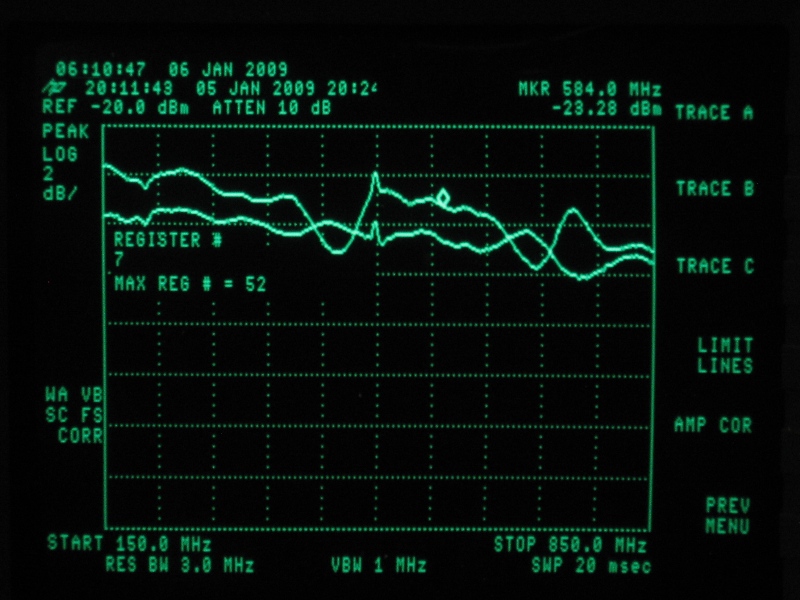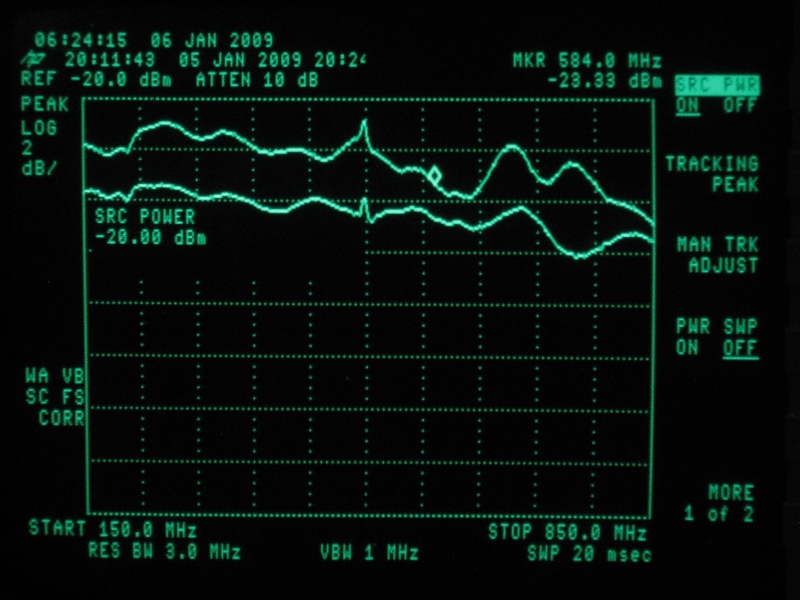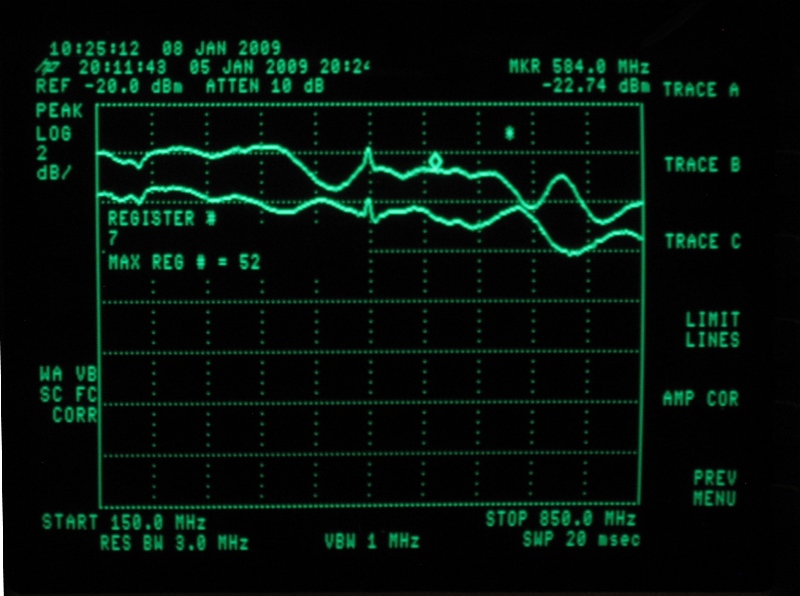Combiner Comparison
The following traces provide some performance comparisons of serveral "off the shelf" VHF/UHF splitters, used as combiners. Details of the measurement setup are provided here.
The bottom trace is resonse with a single signal source, and the unused combiner input terminated. The top trace is response with the same signal source connected to both combinter inputs.
It should be noted the interconnecting cables from signal sources to combiner were both Eagle Aspen 39B2 cable, and were 19", within .1". Both increasing and decreasing the lengths of these cables will move peaks and nulls up or down in frequency. Shorthening or lengthing just one cable can also move a null, and/or introduce additional nulls.
Perfect Vision 22-233

Pico Macom MS-2D

Arista 54-1920

Ace Hardware 3107612

Holland HFS-2

Philmore CS602L

Observation(s)
If you want to combine multiple antennas, a spectrum analyzer can easily become your best friend. It will help you to understand the real response of the specific physical combination of components you've selected, and at the specific frequencies of interest.
Not surprisingly, all splitters are not created equal. Both electrical and internal physical layout/design will affect performance parameters (loss, input port to input port crosstalk, input port to output port crosstalk, etc.).
It is possible to pick very unfriendly combinations of interconnecting cable lengths and combiners, as in the Pico Macom MS-2D and Arista 54-1920. They actually result in about a 1dB and 2 dB of loss, respectively, at about 690 Mhz (Ch 50). But please note this only occurs for this particular choice of coax length. It is possible to adjust the length of either or both interconnecting cables to move this null somewhere else in the spectrum or eliminate it altogether.
Overall, the Perfect Vision appears to have the best UHF band performance, being 2.5dB++ across most of the range. Most others average around 2 dB. Again, note that dip at 700 MHz can be moved.
A Case AGAINST Combining
In general, combining two antennas can be a good bit of work, and you're never going to get more than that 2.5dB gain. One might argue that if you're going to go through that much work, you might as well go for combining 4 antennas and hope for about 5 dB of gain, than to just stop at two.
Signal strength varies dramatically both short term and long term. First of all, there is consistent diurnal variation. Over the course of any given day variations of 6 dB are quite common, and variations in excess of this (8 to 10 dB) have been measured with some regularity. Seasonally, environmental conditions in many areas also vary dramaticaly and bring more or less adversity with them. In urban, hilly, and/or mountainous locations reflected signals can arrive at an antenna at power levels close to the direct path, resulting in inter-symbol interference that eventually results in intolerable error rates. This is known as Multipath, and its different paths can be affected differently by time of day and environmental (weather) conditions, further exaserbating the extremes between good and bad reception. In mountainous regions the presence/absence of snow, and depth of snow pack during winter/summer can affect different signal paths differently.
Reception reliability depends on margin, defined as the amount of signal you have over and above the minimum you need to receive a station. Reliability through adverse environmental conditions depends on that margin. If your signal is just barely on the edge of being receivable (on the "cliff"), 2.5 dB isn't going to buy you much margin, 5 dB might buy you a little. If you are at a point where dropouts or pixelation occur relatively infrequently, 2.5 dB may very well reduce the incidence rate and thus improve reliability. If you are at a point where you can never get a particular station, not even 5 dB is likely to produce 99.9% reliable reception. Consider also that it is quite possible to have perfectly ample signal level and still experience frequent pixellation or dropouts because of multipath. Where that is the case simply increasing signal level is likely to be disappointing.
As a rule of thumb, if you don't have at least about 10 dB of margin during the best of times, you are not likely to withstand the worst of times.
The arguement against combining is that 2 to 4 dB of additional field strength can often be found by repositioning, with considerably less effort and engineering complexity (read: "trial and error"), than combining. Especially in those cases where there are multipath contributors, moving an antenna a few meters one way or the other, increasing its height by a few meters, rotating it slightly off axis to avoid an offending contributor, or elevating it (pointing it upwards) 5 to 10 degrees to avoid ground reflections can produce noticable improvements.
Where transmit towers are at a common location, the use of Yagi based designs versus bow tie designs can help to overcome multipath. Their narrower beam width can help to reject reflected signals arriving off axis (from the sides).
In summary, the only time 2.5 dB of increased signal level is likely to be rewarding is in those scenarios where a station is already "almost" reliable. In those scenarios, there are often more manageable alternatives.
A Case FOR Combining
Where combinning antennas can be rewarding is in cases where multipath is a primary factor. Combining antennas vertically or horizontally has the affect of increasing its directivity vertically or horizontally, respectively. That is, increasing gain in the directly forward direction versus off-axis gain. But one of the biggest issues is determining the source of the interfering signal. It may be ground reflections coming from below, or off some terrain or structure to the side.
In the case of ground reflections, upward tilting of an antenna can help. Improvements of around 10 points have been oberserved on receivers with 0-100 scale "quality" indicators. If you've determined there is sensitivity to upward tilt, but need further improvement (read: "reliability"), two vertically stacked antennas will result in less sensitivty to power coming from below or above the line of sight.
Reflections from the side are commonly associated with buildings, hills, or terrain in general. In these cases, horizontally mounted antennas will narrow the beam width horizontally. Again, increasing the sensitivity directly forward, and reducing sensitivity to the sides.
In General
There is a significant amount of just plain luck involved when combining antennas, especially without adequate instrumentation to characterize your combining network response.
Good luck.